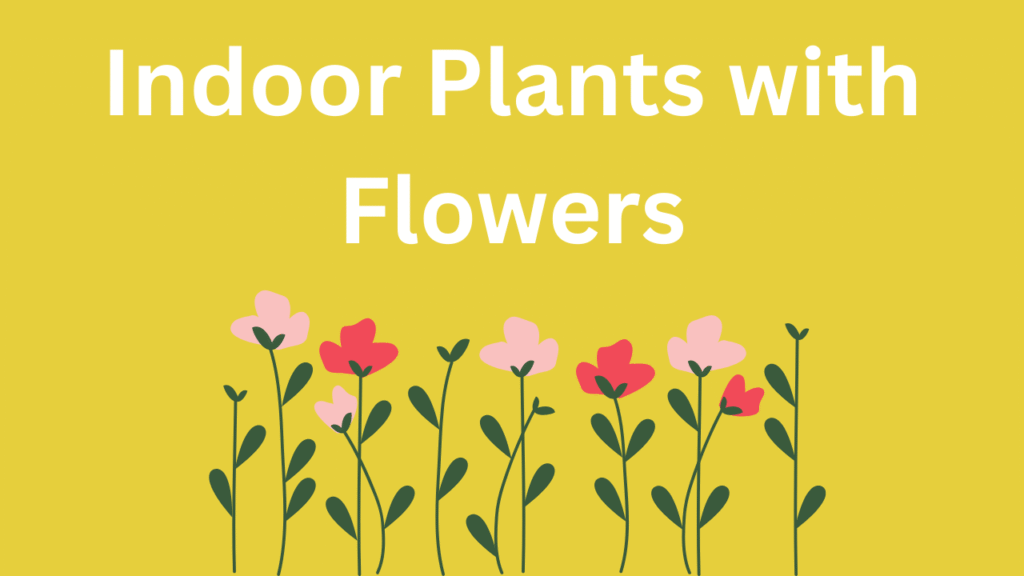Who says indoor plants are only about green leaves? Adding indoor plants with flowers to your home brings more than just greenery—it adds pops of color, sweet fragrances, and an uplifting atmosphere. Flowering indoor plants not only enhance your décor but also improve air quality, reduce stress, and create a welcoming environment.
Whether you’re a beginner just starting your indoor gardening journey or a seasoned plant lover looking to expand your collection, flowering plants are a fantastic choice. In this guide, we’ll explore the best indoor plants with flowers, their care tips, benefits, and how to choose the right blooms for your space.
Why Choose Indoor Plants with Flowers?
More Than Just Beauty
Flowering indoor plants bring vibrant life to your home. Unlike regular foliage plants, these beauties offer:
- Aesthetic charm: Bright blossoms make your rooms lively and elegant.
- Mood boosting: Flowers are scientifically proven to improve mental well-being.
- Air purification: Many flowering plants help remove toxins.
- Year-round color: With proper care, some bloom several times a year.
Top Indoor Plants with Flowers for Your Home
1. Peace Lily (Spathiphyllum)
- Why it’s perfect: Elegant white blooms and glossy leaves.
- Care tips: Thrives in indirect light, keep soil moist but not soggy.
- Bloom season: Spring and summer, sometimes year-round indoors.
- Extra benefit: Known for excellent air-purifying qualities.
2. Anthurium (Flamingo Flower)
- Why it’s perfect: Striking red, pink, or white heart-shaped blooms.
- Care tips: Prefers bright, indirect light and regular watering.
- Bloom season: Nearly year-round with the right care.
- Extra benefit: Adds a tropical touch to any space.
3. African Violet
- Why it’s perfect: Compact size, perfect for small spaces.
- Care tips: Place in bright but indirect light, water from the bottom to avoid leaf spots.
- Bloom season: Multiple times a year if kept happy.
- Extra benefit: Available in a variety of colors like purple, pink, and white.
4. Kalanchoe
- Why it’s perfect: Low-maintenance succulent with colorful blooms.
- Care tips: Needs bright light and minimal watering.
- Bloom season: Winter and spring.
- Extra benefit: Ideal for beginners looking for fuss-free flowers.
5. Orchids (Phalaenopsis Orchid)
- Why it’s perfect: Elegant and long-lasting blooms.
- Care tips: Provide bright, indirect sunlight; water once a week.
- Bloom season: Winter to spring; flowers can last for months.
- Extra benefit: Adds sophistication and a spa-like feel to interiors.
6. Hibiscus
- Why it’s perfect: Large, vibrant blooms in red, yellow, or pink.
- Care tips: Needs lots of sunlight and regular watering.
- Bloom season: Summer, though indoors they can bloom in other seasons too.
- Extra benefit: Can be trained as a small indoor tree.
7. Begonia
- Why it’s perfect: Wide variety of colorful flowers.
- Care tips: Prefers medium light and consistent moisture.
- Bloom season: Spring through fall.
- Extra benefit: Decorative foliage makes it attractive even without flowers.
8. Geranium
- Why it’s perfect: Cheerful clusters of pink, red, or white flowers.
- Care tips: Loves sunlight and needs well-drained soil.
- Bloom season: Spring to summer indoors.
- Extra benefit: Fragrant leaves add another layer of appeal.
9. Jasmine
- Why it’s perfect: Beautiful white flowers with a delightful fragrance.
- Care tips: Needs bright light and regular watering.
- Bloom season: Winter to spring.
- Extra benefit: Adds a sweet aroma that fills the room.
10. Bromeliads
- Why it’s perfect: Exotic, brightly colored blooms.
- Care tips: Thrives in bright, indirect light; water into the central “cup.”
- Bloom season: Once in its lifetime, but flowers last for months.
- Extra benefit: Very low maintenance and long-lasting.
How to Choose the Right Flowering Indoor Plants
When picking indoor plants with flowers, consider:
- Light availability: Orchids and jasmine need more light, while peace lilies thrive in low light.
- Maintenance level: Beginners may prefer African violets or kalanchoe.
- Space size: Small spaces benefit from compact plants like violets, while larger rooms can host hibiscus or bromeliads.
- Climate and environment: Ensure humidity and temperature match the plant’s needs.
Care Tips for Flowering Indoor Plants
Light Requirements
Most flowering plants need bright, indirect light. Place them near windows with sheer curtains to avoid harsh sunlight.
Watering Schedule
- Avoid overwatering, which causes root rot.
- Always check soil moisture before watering.
- Some plants, like African violets, prefer bottom watering.
Fertilizing for Blooms
- Use a balanced liquid fertilizer every 4–6 weeks during the growing season.
- Choose fertilizers high in phosphorus to encourage more blooms.
Pruning and Deadheading
- Remove spent flowers to encourage continuous blooming.
- Trim yellow or damaged leaves regularly.
Managing Humidity
- Many flowering plants love humidity.
- Use a humidifier or place a water tray with pebbles beneath the pot.
Benefits of Indoor Plants with Flowers
- Boosts mood and reduces stress: Flowers bring natural beauty and serenity indoors.
- Improves indoor air quality: Plants like peace lilies filter toxins.
- Adds natural fragrance: Jasmine and geraniums freshen the air naturally.
- Enhances home décor: A pop of color elevates the look of your space.
- Encourages mindfulness: Caring for flowering plants promotes relaxation.
Step-by-Step Guide to Starting Your Indoor Flower Garden
- Choose your plants – Start with low-maintenance options like African violets or peace lilies.
- Pick the right containers – Ensure good drainage to avoid waterlogging.
- Place them strategically – Match each plant’s light needs with the right spot in your home.
- Set a routine – Water, fertilize, and prune regularly.
- Experiment with varieties – Mix plants with different bloom colors for a vibrant look.
- Learn and adapt – Observe your plants and adjust care based on their response.
FAQs About Indoor Plants with Flowers
1. Which indoor plants with flowers are easiest to grow?
Peace lilies, African violets, and kalanchoe are among the easiest for beginners.
2. How do I make my indoor plants bloom more?
Provide enough light, use phosphorus-rich fertilizer, and regularly prune dead flowers.
3. Can flowering indoor plants survive in low light?
Yes, peace lilies and begonias can tolerate low-light conditions.
4. Do indoor flowering plants need special soil?
Most prefer well-draining soil with organic matter. Orchids, however, need special orchid mix.
5. Are flowering indoor plants safe for pets?
Not all are safe. For example, lilies are toxic to cats and dogs. Always check plant safety before bringing them home.
Conclusion
Indoor plants with flowers are the perfect way to combine greenery with vibrant beauty. From the elegant orchid to the easy-to-grow African violet, there’s a blooming plant for every space and skill level. Not only do they brighten your home décor, but they also improve air quality, reduce stress, and create a joyful atmosphere.
🌸 Ready to add life and color to your home? Start your flowering plant journey today and discover more guides, tips, and plant care secrets at Green Plant Zone.

Hi, I’m the creator of Green Plant Zone, a space dedicated to plant lovers. I share tips on indoor and outdoor gardening, plant care guides, and eco-friendly living. My mission is to help you grow healthier, happier plants and bring more greenery into everyday life.
